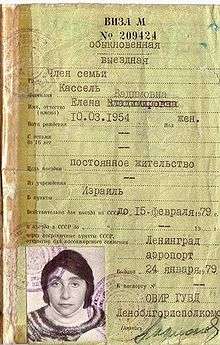1970s Soviet Union aliyah
| Part of a series on |
| Aliyah |
|---|
 |
| Jewish immigration to the Land of Israel |
| Concepts |
| Pre-Modern Aliyah |
| Aliyah in modern times |
| Absorption |
| Organizations |
| Related topics |

Aliyah was the mass immigration of Soviet Jews during the 1970s to Israel after the Soviet Union lifted its ban on Jewish Refusenik emigration.
Background
In 1967, the USSR broke diplomatic relations with Israel in the wake of the Six-Day War. During this time, popular discrimination against Soviet Jewry increased, led by an anti-Zionist propaganda campaign in the state-controlled mass media. By the end of the 1960s, Jewish cultural and religious life in the Soviet Union suffered from a strict policy of discrimination. This state-sponsored atheism movement denied Jews the ethnic-cultural rights experienced by other Soviet ethnic groups.[1]
Emigration policy
After the Dymshits–Kuznetsov hijacking affair in 1970 following the crackdown, international condemnations caused the Soviet authorities to increase emigration quotas. Between 1960 and 1970, only 4,000 people had left the USSR. The number rose to 250,000 in the following decade.[2]
In 1972, the USSR imposed a so-called "diploma tax" on would-be emigrants who had received higher education in the USSR. The fee reached as high as twenty times an annual salary. This measure was designed to combat the brain drain caused by the growing emigration of Soviet Jews and other members of the intelligentsia to the West. Following international protests, the Kremlin soon revoked the tax, but continued to sporadically impose various limitations.
Emigration
Prior to the Six-Day War, few Soviet Jews emigrated to Israel. Israel's decisive victory changed the opinion of many Soviet Jews towards Israel. After the war, many Soviet Jews began to demand the right to move to Israel. However, given a choice, many Soviet Jews chose to emigrate to the US.[3]
Absorption of new immigrants in Israel
_-_A_Tearful_Reunion.jpg)
In 1968, 231 Jews were granted exit visas to Israel, followed by 3,033 in 1969. From that point on, the USSR began granting exit visas in growing numbers. During the late 1960s and the 1970s, some 163,000 Soviet Jews emigrated to Israel; mostly between 1969 and 1973.
While many Jews emigrated to Israel, others chose the United States instead. Known as "dropouts", the emigres applied for US refugee visas while waiting at transit centers in Europe. In March 1976, the "dropout rate" rose to over 50%. Most of the Soviet Zionists who wanted to emigrate to Israel out of religious and/or ideological reasons had done so by 1973; from then on, most Soviet-Jewish emigrants were mostly motivated by economic concerns. Many were non-religious and saw themselves as Jews by nationality only, and thus they had little religious or ideological motivation to move to Israel, which they saw as having fewer opportunities than the United States.[4]
Most Soviet Jews who emigrated to Israel who had stronger Jewish identities came from the Baltic states, Moldova, and Georgia, while the "dropouts" were mainly assimilated Jews from the Russian heartland.[4] Overall, between 1970 and 1988, some 291,000 Soviet Jews were granted exit visas, of whom 165,000 immigrated to Israel, and 126,000 immigrated to the United States.[5]
See also
- Refusenik (Soviet Union)
- Dymshits–Kuznetsov hijacking affair
- Jackson–Vanik amendment
- History of the Jews in Russia and the Soviet Union
- 1990s Post-Soviet aliyah
- Russian Jews in Israel
- USSR anti-religious campaign (1970s–87)
References
- ↑ Decter, Moshe. The Status of the Jews in the Soviet Union. Foreign Affairs. January 1963.
- ↑ History of Dissident Movement in the USSR by Ludmila Alekseyeva. Vilnius, 1992 (in Russian)
- ↑ Lazin, Fred. Refugee Resettlement and 'Freedom of Choice': The Case of Soviet Jewry. Center for Immigration Studies. July 2005.
- 1 2
- ↑ Tolts, Mark. Post-Soviet Aliyah and Jewish Demographic Transformation. 15th World Congress of Jewish Studies, Jerusalem. August 2-6, 2009.